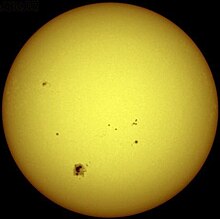Solar cycle 23

Solar cycle 23 is the 23rd solar cycle since 1755, when recording of solar sunspot activity began.[1][2] The solar cycle lasted 12.6 years, beginning in May 1996 and ending in December 2008. The maximum smoothed sunspot number (monthly number of sunspots averaged over a twelve month period) observed during the solar cycle was 120.8, and the minimum was 1.7.[3] There were a total of 805 days with no sunspots during this cycle.[4][5][6]
One of the first major aurora displays of solar cycle 23 occured in April 6, 2000, with bright red auroras visible as far south as Florida and South Europe.[7] On July 15, 2000, a strong G5 geomagnetic storm (the Bastille day storm) caused damage to GPS systems and in some power companies. Auroras were visible as far south as Texas.[8] Another major aurora display was observed in April 1, 2001, due to a coronal mass ejection hitting the Earth's magnetosphere. Auroras were observed as far south as Mexico and South Europe. The following day, a very large solar flare occured in April 2, 2001 (X20) but the blast was directed away from Earth. In late October 2003, a series of large solar flares occured. A X17 flare in October 28, 2003 (X17) resulted in autoras visible as far south as Florida and Texas.[9] A few days later, the largest solar flare ever measured with instruments occured in November 4, 2003 (initially measured at X28 and later upgraded to X45).[10][11] This flare was not Earth-oriented and thus only resulted in high-latitude auroras. Another large solar flare occured in September 7, 2005 (X17) with auroras visible in mid-latitudes. A complete list of the larger solar flares of this cycle is available at http://www.spaceweather.com/solarflares/topflares.html
See also
References
- ^ Kane, R.P. (2002). "Some Implications Using the Group Sunspot Number Reconstruction". Solar Physics 205(2), 383-401.
- ^ "The Sun: Did You Say the Sun Has Spots?". Space Today Online. Retrieved 12 August 2010.
- ^ SIDC Monthly Smoothed Sunspot Number. "[1]"
- ^ Spotless Days. "[2]"
- ^ What's Wrong with the Sun? (Nothing) more information: Spotless Days. "[3]"
- ^ Solaemon's Spotless Days Page. "[4]"
- ^ http://science.nasa.gov/science-news/science-at-nasa/2000/ast25apr_1m/
- ^ http://science.nasa.gov/science-news/science-at-nasa/2000/ast14jul_2m/
- ^ http://sohowww.nascom.nasa.gov/hotshots/2003_10_28/
- ^ http://sohowww.nascom.nasa.gov/hotshots/2003_11_04/
- ^ http://www.spaceref.com/news/viewpr.html?pid=13844
